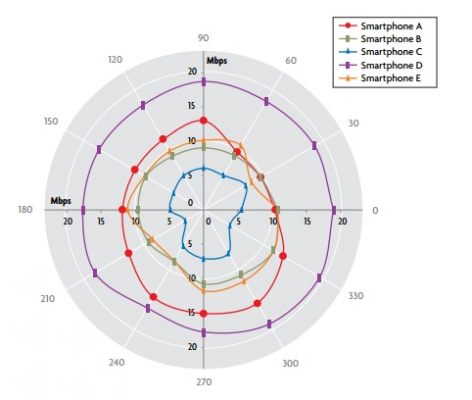Moto X is the phone that keeps on giving. For a phone that was very controversial initially because of its apparent mid-range specs (with a high-end price tag), it seems to keep surprising us with features that are better than the ones from the competitors. This time, Moto X proved that it can keep a LTE connection more consistently and at a 35 percent higher throughput on average compared to smartphones like the Samsung Galaxy S4, Samsung Galaxy Note 2, HTC One, LG G2.
After a series of tests, it was shown that the Moto X can keep a connection at a signal level 9db lower than its competitors. All phones were put in an echo-free chamber for 14.4 hours and 860 minute-length tests were performed on them, so this wasn’t just a quick Speedtest.net test. They tested different angles and power levels to see how the signal and strength of the connectivity varies.
The Moto X test was done on Verizon’s 700 MHz Band 13, and the others on AT&T’s 700 MHz Band 17, but Michael Thelander, Signals Research’s founder and CEO, says “I’m confident that if we had tested a Moto X phone that supported Band 17 in Band 17 that the results would be largely the same”.
Thelander also said that “If you’ve got a device out there that’s making inefficient use of resources, it’s impacting everybody else on the network”. When a device is not connecting in a very efficient manner, than it will take more resources from the carriers’ own towers. It may not be a big deal if only a few units do it, but multiply by a few million, and then it becomes a more major problem. That’s why Thelander urges OEMs to use LTE chips that provide a more efficient and consistent performance.
The test also came out largely positive on the use of MIMO technology, which shows some incremental improvement when it comes to using a high-speed connection and the signal is strong enough. However, if the signal is weak, MIMO can actually show negative improvement, and it may be better to use transmit diversity.
Hopefully, more OEMs will begin to care about offering good LTE performance in their devices, and not just throw their chips in there as long as they have the LTE, or LTE-A label on them. Far too often OEMs tend to care more about what they can say in their marketing campaigns than about certain components, than about how they actually perform in the real world, and it should be the other way around, or should should care about real-world performance at least as much as they do about how they promote it.
 TechDomino
TechDomino




